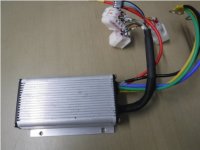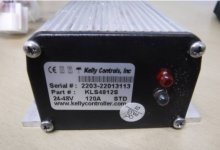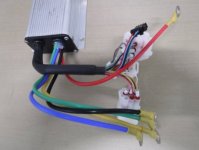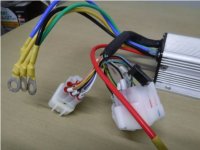The IQ settings should generally not be messed with in my opinion.
Maybe something can be set here to increase efficiency, no idea how or what should be changed though.
On a QS 138 I've noticed that it was getting warm fairly quickly, just by chance I ran the auto identify procedure again and suddenly it ran much cooler. Maybe you could try to run auto identify again to see if the consumption changes.
For me the speed kp and ki values are always set to max as this maximizes torque especially at low rpm. If you're getting too large current spikes you could try actually lowering these two values.
The speed err limit refers to how strict the set rpm limit is held. For instance if it's set to a high value it will overshoot the set speed for a second or so. Set it to a small value and it will cut current abruptly as it reaches the set value.
The pole count is just to determine rpm, most people don't need to change it.
I did phase identification couple of times already but no changes really. Just to clarify, controller doesn't get very hot but just warmer than my generic controllers. I would say about 45c in normal use vs about body temperature for generic controllers. Noticed there is controller temperature in the program so will need to check exact temperature during use.
Is there any way to "factory reset" the controller and change settings to default? Since I bought it used, I don't know actually which settings have been played with and which are default so it could be already all over the place when I received it...
After trying to figure it out for a while, today I said screw it, and started playing with settings, good old trial and error style. Wanted to see what kind of effect they have on noise, current draw and rpm. Needless to say I am even more confused now lol.
Settings with received controller are as following:
IQ Kp 1500
IQ Ki 30
ID Kp 1500
ID Ki 30
Torque Speed Kp 3000
Torque Speed Ki 80
Speed Err limit 1000
With these settings, motor spins at 336rpm with no load. That equals to exactly 42kmh.
So first I've mainly played with IDs (direct) trying to achieve more RPM since it's to my understanding responsible for magnetic flux as opposite to IQ (quadrant) which is responsible for Torque. It deffinitely affects the top speed and how motor behaves near top speed but I was never able to achieve higher top speed, only lower.
I tried all sorts random and bogus numbers like ID Kp 30000 ID ki 1000, both 30000, Ki higher than Kp etc. I've found that with both set to 0, motor is able to spin at 390- 395rpm which is quite a gain. That would equal to 50km/h. The problem is, when under load, once it's I'm around 34-35, it's sort of like the timings go out of whack and so it runs out of steam, starts making slight noise and it tops out at around 37kmh, rather than achieveng 390rpm and 50kmh. So, with no load it spins FASTER than when set to 1500, 30 but when under load it's actually slower. Pretty interesting...
I tried changing IQs as well and it goes all the way from motor not moving at all (0) to locking completely into place (30 000 and such settings). I eventually returned IQs back and I settled with ID Kp 7000 and ID Ki 300 since I found that while not increasing top speed, it does get more alive near top speed.
I also played with PWM and the sound at lowest 5 is actually quite annoying, coil whine like rather than that motor growl that cheaper controllers get so It's probably best to leave at max 20, unless it really has a huge impact on controller's power consumption (will test further).
Changed throttle MAP to 70 as I prefer it to be more responsive after 50% of throttle.
Then I also changed :
Torque Speed Kp to 1500, Torque Speed Ki to 100 and Speed Err limit 2000.
On to my surprise, all of this didn't had too much impact on the current drawn from the batterry for given load but it's really hard to track what's happening in which moment. I would still overshoot so I've lowered batt current to 30%, and even still, it will spike over 40A in some moments. Seems like I will need to lower phase current as well to avoid spiking over 40A...
Went on a 35km round commute again (70km total) and I did end up spending a bit less battery. The bike is more smoother in the range I ride the most but power cuts out a bit more abruptly and with slight lag once you release the throttle (you can kinda hear the "magnets" for a brief moment once it does). As always, there were few situations where I needed that 40 over punch so it's quite annoying. Also, that "regen" effect appeared where when you release throttle on higher speed then give it again, motor will actually try to slow down for brief moment as you're passing through lower throttle input.
I've also tried changing poles count just to see what it does and I haven't noticed any changes in operation, other than program showing wrong RPMs.
Overall, it's quite above my "expertise" and it doesn't help that Kelly slightly skews terminology while using unknown units etc. I know it's all way too complicated for simple posts but if there is any kelly controller or FOC expert in general that would like to chime in on PID settings, just for laughs, it's very welcome.
In the meantime, I've contacted Kelly to ask specifically about field weakening for this controller. My message:
Hello,
I have purchased your KLS4812S controller. Is it possible in any way to setup a field weakening / phase advancing with this controller?
Thanks
Reply I got is:
The default program is without weak magnetic function. Special instructions are required before purchasing.
Thank you!
Not sure I understand what exactly they mean with this... Whether they will flash some sort of special firmware, or send you some sort of special instructions or just simply instruct you to buy their controller which does have it.





